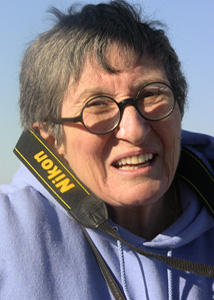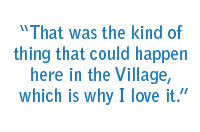 Writer and photographer Nancy Bogen was born in Brooklyn in 1932. For thirty years she taught English Lit at Richmond College and the College of Staten Island, retiring as professor emeritus in 1997. The author of three novels, including “Klytaimnestra Who Stayed at Home,” as well as a photographer, she lives with her husband, Arnold, on Jane Street.
Writer and photographer Nancy Bogen was born in Brooklyn in 1932. For thirty years she taught English Lit at Richmond College and the College of Staten Island, retiring as professor emeritus in 1997. The author of three novels, including “Klytaimnestra Who Stayed at Home,” as well as a photographer, she lives with her husband, Arnold, on Jane Street.
“I’m no normal 79-year-old,” boasts writer and photographer Nancy Bogen. “I run about two miles every day. I also engage in sports. I play Ping Pong, and I used to fence at the Salle Santelli on Sixth Avenue. It’s not only for my health that I exercise, but for my frame of mind as well. I think it keeps me rather sane, for one. It keeps the cobwebs away.”
It’s this kind of energy that has seen the long-time West Villager through a number of careers, beginning with one as a writer. “My parents were not professional writers, but they wrote well. I remember as a little girl I went to public school in Brooklyn and I had a teacher who was a real meanie. It took a lot impress her, but she once looked at me and said, ‘You know, you can write!’ That was the beginning of my career,” she says, laughing.
As an adult, Bogen went on to write three novels of ideas and many scholarly articles. Eventually the late John Gardner, the best-selling author of novels such as The Sunlight Dialogues, befriended her. “He loved my first novel and went to bat for it,” she recalls. “He was advising me about what would become my third novel when he was killed in a motorcycle accident. That was devastating to me.” At the same time, Bogen’s serious fiction writing all went—according to her—“down hill.” “That’s because the kind of novel I was writing—the novel of ideas that required full attention—began to lose its audience,” she says. “And even though they loved my writing, my agents couldn’t place my work anymore.” For Bogen, this was a harbinger of the current lamentable state of literature. “Nobody reads serious fiction any more!” she says. “It’s gone, it’s finished, the art of reading. Ask young people if they’ve read Ulysses, or anything by William Faulkner. Thomas Wolfe is a complete unknown. It can be very depressing if you let it get to you.”
Bogen shifted gears when she retired from teaching in 1997 and founded a small performance group called The Lark Ascending. “I always loved music, and my mission was to create performances that included both that and literature, related by scene or period,” she explains. “I would commission an 8–10 minute piece by a living composer. I felt that composers had no one to speak for them. The music is there in notes on paper but if they don’t get a performance, no one hears it.”
 Throughout it all, Bogen was an avid photographer. “I started out as a writer but I always wanted to be a photographer,” she admits. “Once I was established in a teaching career with a regular income I began doing photography; very modestly at first, and then more and more. But I found shooting film very limiting, and when digital imaging came along I really felt that I came into my own. It’s all come together. I’m now finding myself as both a writer and digital imagist and putting it with text and music on Vimeo.”
Throughout it all, Bogen was an avid photographer. “I started out as a writer but I always wanted to be a photographer,” she admits. “Once I was established in a teaching career with a regular income I began doing photography; very modestly at first, and then more and more. But I found shooting film very limiting, and when digital imaging came along I really felt that I came into my own. It’s all come together. I’m now finding myself as both a writer and digital imagist and putting it with text and music on Vimeo.”
A West Village resident since 1971, Bogen had her first one-person show as a photographer right here on Bleecker Street. In recollecting it, she tells the kind of story that for her could only happen in the Village.
“I had been home bound for three months with a hurt back,” she says. “The doctor said I could get up for only ten minutes a day. So for those ten minutes, I shot pictures from my apartment window. I shot whatever went by: balloons, helicopters, clouds, you name it. Afterwards, I went to the 380 Gallery and told the owner that this was how I happened to take the pictures. He took one look and said, ‘I’m going to give you a show.’
“I was an unknown!” she continues. “An utter stranger. I never had anything happen like that anywhere else in New York. But that was the kind of thing that could happen here in the Village, which is why I love it.”
Photo: Nancy Bogen
